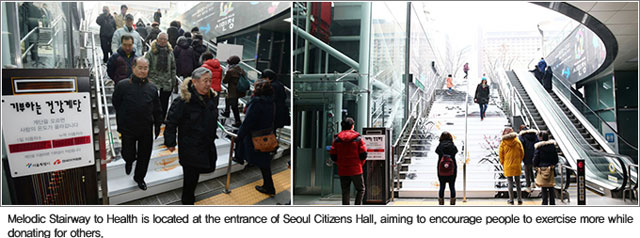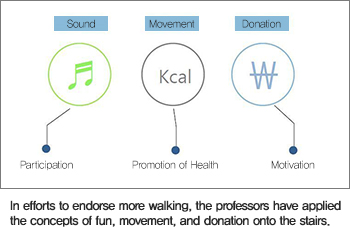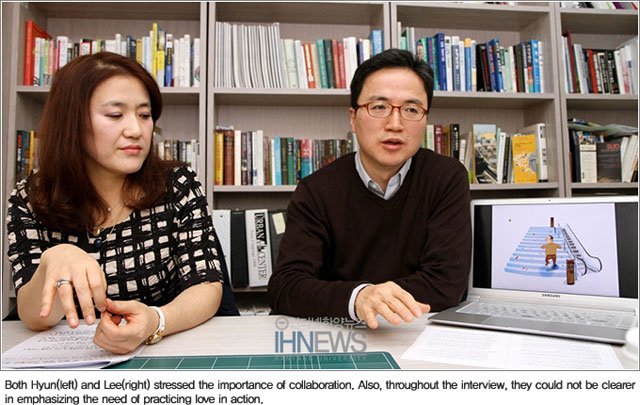Design and Engineering meet for practice of love
Declaring war against obesity, the Seoul Metropolitan Government has worked hard to lower the rate of obesity among Seoul citizens. In line with such a goal, local governments have attempted to encourage fun with exercise with a brand new staircase at the new Seoul Citizens Hall building.
Eunryoung Hyun(Professor. Applied Art Education) and Sugie Lee(Professor. Urban Engineering) have worked together to introduce fun and function into the stairs at the Seoul Citizens Hall since May, 2013. The two professors transformed the stairs into a gigantic functioning Gayageum – a Korean harp with twelve strings – with a traditional Korean design. Sponsored by Hankuk Yakurt, a yogurt company, the staircase was constructed in order to encourage people to use the stairs with KRW 10 donated per person that does. Internet Hanyang News (IHN) met with the two professors to hear more about the project.
Introducing the brand new Melodic Stairway to Health
 |
With the launch of the musical stairs, people soon gained interest in the intriguing new stairway and enjoyed making sound with movements, donating as they ascended up and down the stairs. Professor Lee commented, "The Fun Theory has been applied to the project, which indicates that fun obviously can change behavior for the better." He added that due to living hectic lives, people have less time for a regular workout; therefore, it became natural to think about how to successfully make the most of spare time, such as time spent for commuting, to exercise. Professor Hyun continued, "It was very difficult to think of the design for the stairs. The local government wanted it to be traditionally Korean style, but as neighboring Asian cultures somehow overlap the Korean one, it was tough to choose one design that would solely fit Korean identity."
The Stairway to Health displays the ten traditional symbols of longevity with the Gayageum melody. At first, the design was planned to be carp, but there were concerns it would not go far enough to represent Korea. Furthermore, owing to the fact that the place has a lot of young pedestrians and commuters, the professors first attempted a beat box sound, but in the end selected the Gayageum melody. Therefore, the authorities and the professors have deliberated how to best represent the significance Seoul Citizens Hall has and the harmony to be made. As a result, they decided to put the ten symbolic animals of longevity including the carp which has the meaning of birth in an effort to reflecting Korean traditional sentiment.
What did they realize through collaboration? What HYU has always emphasized
 |
Prior to embarking on the project, when they first went out for examination, they concluded that 96 percent of commuters would use the escalator rather than the stairs. To endorse more walking, Lee and Hyun pinpointed three major factors in building the new stairs: fun, movement, and motivation. Hyun said, "The authorities have stressed, above all, movement." As for motivation, it brought about the issue of incentive. Lee explained, "People tend to do strenuous things when there is an incentive. Furthermore, to our surprise, people like to share incentives, rather than gaining all benefits themselves As a result, donation could be realized." Most importantly, the stairway is the very first public space-form donation system. Both Lee and Hyun are happy to be at the forefront of such a revolutionary move and to realize the practice of love with their students at HYU.
However, the project was not an easy one. Lee and Hyun unanimously agreed that the project required a great deal of time and efforts; they continued cooperating and enduring hardship, bearing in mind the importance of practicing love in action. They first met at the training course following their faculty appointment, and there they have introduced their interest and academic studies to each other. As a result, they could find a common interest and a hint for collaboration, and ended in working on a couple of projects, such as STEAM and Hanyang Towner, along with their students.
Accordingly, they emphasized the significance of collaboration. They both voiced that convergence is not an option, but a must. Lee explained, "Urban Engineering in particular is born to be collaborated with other majors. When it comes to working with another major, communication should come ahead of any other thing." Understanding and finding a common interest in two or three different majors, according to the two, comes from constant interaction. Hyun added, "HYU has almost every major that you can find. It is the best place to pursue diversity."
 |
As borders between academics grow and the society continues to change, convergence has become a compulsory step to pursuing deeper, more interconnected studies. The professors said that students need to recognize phenomenon and take action. Professor Lee recommended a book called The Age of Access by Jeremy Rifkin. He said, "The book introduces the concept of a shared city where people no longer possess and move onto sharing." According to them, their public design is based upon the idea of a shared city.
They have remarked that gaining help and advice from another field of study should first take place when conducting more practical and innovative studies. Furthermore, they advised HYU students to be more active in realizing love into action. The Stairway to Health locates at the entrance of Seoul Citizens Hall and IHN recommends HYU students to come and see the stairway, and donate by exercising.
Ally Jeong
allyjeong@hanyang.ac.kr
Other articles written by this reporter
Photo by Bomin Park
